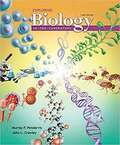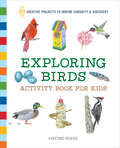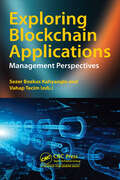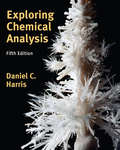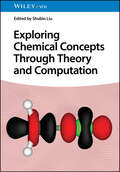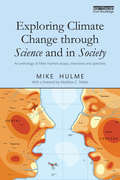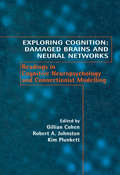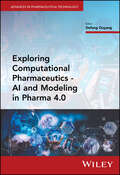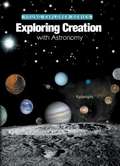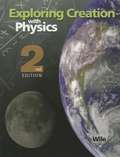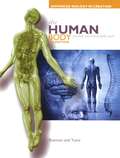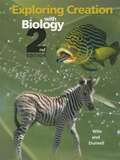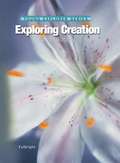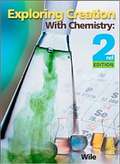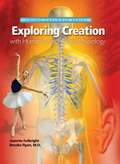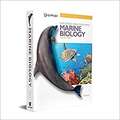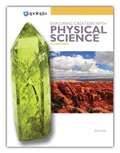- Table View
- List View
Exploring Biology in the Laboratory
by Murray P. Pendarvis John L. CrawleyThis full-color, comprehensive, affordable introductory biology manual is appropriate for both majors and nonmajors laboratory courses. All general biology topics are covered extensively, and the manual is designed to be used with a minimum of outside reference material. The activities emphasize the unity of all living things and the evolutionary forces that have resulted in, and continue to act on, the diversity that we see around us today. Features: An extensive full-color art and photography program includes many specimen and dissection images, labeled diagrams, cladograms, and helpful life-cycle illustrations. In addition to providing the necessary images to help students work through the lab procedures, the manual also includes hundreds of images of representative organisms, providing ample visual support for the lab. Check Your Understanding questions after each exercise ask thought-provoking questions in order to measure student progress throughout the chapter. A Chapter Review ends each chapter and provides thoughtful questions to ensure that students understand the overall concepts from the chapter.
Exploring Biology: An Inquiry Approach
by William R. Bowen Frank A. Romano III Benjamin G. Blair Stacy BlairExploring Biology: An Inquiry Approach Jacksonville State edition
Exploring Birds Activity Book for Kids: 50 Creative Projects to Inspire Curiosity & Discovery
by Kristine RiversExplore the world of birds with hands-on activities for kids ages 8 to 12 Get kids excited about all the beautiful birds that live around them! This bird book for kids is full of fun and games to help young explorers discover the amazing diversity of birds and how important they are to our ecosystem. Inside, they'll discover a wide range of fun things to try, like sketching birds, creating a map of different bird sounds, using binoculars, and more! Go beyond other nature books for kids: Birding basics—This book features simple guidance for going birding, from packing the right tools to observing and recording what they see. Anytime, anywhere—Find tips for successful birdwatching anywhere, whether it's a rural area or a big city. Spark their sense of discovery—Show kids how to respectfully engage with birds in their own habitat and how much birds can teach us. Give curious kids the tools to set off on their own birding adventures with this ultimate bird book for kids.
Exploring Blockchain Applications: Management Perspectives
by Vahap Tecim Sezer Bozkus KahyaogluIn this book, the development process of blockchain algorithms and examples of their applications in different sectors are explored. The opportunities and challenges of blockchain implementations that arise in making technological innovations usable in corporate structures are discussed. In this respect, the book aims to deal with both the conceptual framework and the real challenges and opportunities encountered in practice regarding the blockchain applications. It is tried to contribute to the literature by presenting practical blockchain application suggestions to the readers on a scientific basis.It is a fact that blockchain technology is considered one of the most disruptive and revolutionary innovations after the invention of the internet. Blockchain technology, which was first used for cross-border payments, is coming up with a new application area in a different sector every day. The main purpose of Blockchain-based systems is to spread the "trust" service provided by a central intermediary to machines in transactions between two parties. Thus, it removes the need for this trust from the monopoly of a single intermediary. Blockchain implementation scenarios are to establish math-based trust in an untrusted environment.While exploring the complexity of blockchain applications in different sectors, the emerging risks are also examined from a management perspective. In particular, it is aimed to be a key work that the management levels of the enterprises can benefit from in the decision-making processes.It will be seen that blockchain technologies will be used unlimitedly in design, planning, management and decision making. This book will also introduce new visions for practitioners to use different blockchain technologies and methodologies to face problems.
Exploring Chemical Analysis: International Edition
by Daniel HarrisCombining coverage of all major analytical topics with effective problem-solving methods, Exploring Chemical Analysis provides an ideal introduction to analytical chemistry.
Exploring Chemical Concepts Through Theory and Computation
by Shubin LiuExploring Chemical Concepts Through Theory and Computation Deep, theoretical resource on the essence of chemistry, explaining a variety of important concepts including redox states and bond types Exploring Chemical Concepts Through Theory and Computation provides a comprehensive account of how the three widely used theoretical frameworks of valence bond theory, molecular orbital theory, and density functional theory, along with a variety of important chemical concepts, can between them describe and efficiently and reliably predict key chemical parameters and phenomena. By comparing the three main theoretical frameworks, readers will become competent in choosing the right modeling approach for their task. The authors go beyond a simple comparison of existing algorithms to show how data-driven theories can explain why chemical compounds behave the way they do, thus promoting a deeper understanding of the essence of chemistry. The text is contributed to by top theoretical and computational chemists who have turned computational chemistry into today’s data-driven and application-oriented science. Exploring Chemical Concepts Through Theory and Computation discusses topics including: Orbital-based approaches, density-based approaches, chemical bonding, partial charges, atoms in molecules, oxidation states, aromaticity and antiaromaticity, and acidity and basicityElectronegativity, hardness, softness, HSAB, sigma-hole interactions, charge transport and energy transfer, and homogeneous and heterogeneous catalysisElectrophilicity, nucleophilicity, cooperativity, frustration, homochirality, and energy decompositionChemical concepts in solids, excited states, spectroscopy and machine learning, and catalysis and machine learning, as well as key connections between related concepts Aimed at both novice and experienced computational, theoretical, and physical chemists, Exploring Chemical Concepts Through Theory and Computation is an essential reference to gain a deeper, more advanced holistic understanding of the field of chemistry as a whole.
Exploring Climate Change through Science and in Society: An anthology of Mike Hulme's essays, interviews and speeches
by Mike HulmeMike Hulme has been studying climate change for over thirty years and is today one of the most distinctive and recognisable voices speaking internationally about climate change in the academy, in public and in the media. The argument that he has made powerfully over the last few years is that climate change has to be understood as much as an idea situated in different cultural contexts as it is as a physical phenomenon to be studied through universal scientific practices. Climate change at its core embraces both science and society, both knowledge and culture. Hulme’s numerous academic and popular writings have explored what this perspective means for the different ways climate change is studied, narrated, argued over and acted upon. Exploring Climate Change through Science and in Society gathers together for the first time a collection of his most popular, prominent and controversial articles, essays, speeches, interviews and reviews dating back to the late 1980s. The 50 or so short items are grouped together in seven themes - Science, Researching, Culture, Policy, Communicating, Controversy, Futures - and within each theme are arranged chronologically to reveal changing ideas, evidence and perspectives about climate change. Each themed section is preceded with a brief introduction, drawing out the main issues examined. Three substantive unpublished new essays have been specially written for the book, including one reflecting on the legacy of Climategate. Taken as a collection, these writings reveal the changes in scientific and public understandings of climate change since the late 1980s, as refracted through the mind and expression of one leading academic and public commentator. The collection shows the many different ways in which it is necessary to approach the idea of climate change to interpret and make sense of the divergent and discordant voices proclaiming it in the public sphere.
Exploring Cognition: Readings in Cognitive Neuropsychology and Connectionist Modelling
by Gillian Cohen Robert A. Johnston Kim PlunkettExploring Cognition: Damaged Brains and Neural Networks analyses the contribution made by cognitive neuropsychology and connectionist modelling to theoretical explanations of cognitive processes. Bringing together evidence from both damaged brains and neural networks, this exciting and innovative approach leads to re-evaluation of traditional theories: connectionist models lesioned to mimic the residual function of the damaged brain and rehabilitated to simulate the process of recovery suggest underlying mechanisms and challenge previous interpretations.In this reader key articles by leading international researchers are combined with linking commentaries that provide a context, highlight the conceptual themes and evaluate the evidence. Carefully selected to include hotly debated topics, the papers cover, among others, the controversies surrounding explanations for category specificity in object recognition and for covert recognition of faces and words; the mechanisms underlying the use of regular and irregular past tenses; and the reading of regularly and irregularly spelled words. The challenges posed by connectionist models to assumptions about the nature of dissociations, the need for symbolic rule-based operations in language processing and the modularity and localisation of processes are assessed.Exploring Cognition: Damaged Brains and Neural Networks will be of interest to advanced undergraduates, postgraduates and researchers in cognitive neuropsychology and cognitive neuroscience.
Exploring Computational Pharmaceutics: AI and Modeling in Pharma 4.0 (Advances in Pharmaceutical Technology)
by Defang OuyangProvides an extensive and up-to-date overview of the theory and application of computational pharmaceutics in the drug development process Exploring Computational Pharmaceutics - AI and Modeling in Pharma 4.0 introduces a variety of current and emerging computational techniques for pharmaceutical research. Bringing together experts from academia, industry, and regulatory agencies, this edited volume also explores the current state, key challenges, and future outlook of computational pharmaceutics while encouraging development across all sectors of the field. Throughout the text, the authors discuss a wide range of essential topics, from molecular modeling and process simulation to intelligent manufacturing and quantitative pharmacology. Building upon Exploring Computational Pharmaceutics - AI and Modeling in Pharma 4.0, this new edition provides a multi-scale perspective that reveals the physical, chemical, mathematical, and data-driven details of pre-formulation, formulation, process, and clinical studies, in addition to in vivo prediction in the human body and precision medicine in clinical settings. Detailed chapters address both conventional dosage forms and the application of computational technologies in advanced pharmaceutical research, such as dendrimer-based delivery systems, liposome and lipid membrane research, and inorganic nanoparticles. A major contribution to the development and promotion of computational pharmaceutics, this important resource: Discusses the development track, achievements, and prospects of computational pharmaceutics Presents multidisciplinary research to help physicists, chemists, mathematicians, and computer scientists locate problems in the field of drug delivery Covers a wide range of technologies, including complex formulations for water-insoluble drugs, protein/peptide formulations, nanomedicine, and gene delivery systems Focuses on the application of cutting-edge computational technologies and intelligent manufacturing of emerging pharmaceutical technologies Includes a systematic overview of computational pharmaceutics and Pharma 4.0 to assist non-specialist readers Covering introductory, advanced, and specialist topics, Exploring Computational Pharmaceutics - AI and Modeling in Pharma 4.0 is an invaluable resource for computational chemists, computational analysts, pharmaceutical chemists, process engineers, process managers, and pharmacologists, as well as computer scientists, medicinal chemists, clinical pharmacists, material scientists, and nanotechnology specialists working in the field.
Exploring Creation With Astronomy
by Jeannie K. FulbrightThis book covers the major structures of our solar system, starting with the sun and working towards Pluto.science enchanting and memorable for students.
Exploring Creation With Physics
by Jay WileThis college-prep physics course is designed for the student who has completed algebra and has had an introduction to the definitions of sine, cosine, and tangent. It provides a detailed introduction to the methods and concepts of general physics. Heavily emphasizing vector analysis, this text is ideal preparation for a university-level physics course. It provides the student with a strong background in one-dimensional and two-dimensional motion, Newton s laws and their application, gravity, work and energy, momentum, periodic motion, waves, optics, electrostatics, electrodynamics, electrical circuits, and magnetism. The student text contains all student material, on-your-own questions and solutions, laboratory exercises, and chapter study guides. Color illustrations and diagrams."
Exploring Creation with Advanced Biology: The Human Body
by Marilyn Shannon Rachael YunisThis advanced biology course covers the anatomy and physiology of each of the human body s organ systems, while giving God the glory for His creation. Students taking this course should have successfully completed both biology and chemistry.
Exploring Creation with Astronomy 2nd Edition (Apologia’s Young Explorer Series)
by Jeannie K. FulbrightThis textbook is designed to launch your mind on an educational journey through God's incredible universe. It will bring the cosmos into your home through the exploration of the major structures of our solar system, including the sun, planets, and asteroid belt. It then journeys into the stars and galaxies to explain how marvelous and mighty our Creator is.
Exploring Creation with Biology (2nd edition)
by Jay L. Wile Marilyn F. DurnellAre you ready to be impressed? If not, you'd better get ready. Why? Because in this course, you are going to get a broad overview of God's creation. As you begin to learn its secrets, you will become more and more impressed with its majesty and complexity. The sheer grandeur of it all should leave you in awe of God's mighty power. If you learn nothing else in this course, learn to appreciate the wonder of God's creation! If you are like most students, this will be the first truly rigorous science course that you have ever taken. Thus, you might find it difficult to adjust to the time and patience required by a course like this. If you find yourself getting frustrated or discouraged, remember that whether you decide to go to college, go straight into the workforce, or get married and become a full time parent, there will be many tasks more rigorous than the experience of studying biology. Thus, you need to stick with it, because life is full of challenges!
Exploring Creation with Botany
by Jay L. Wile Jeannie FulbrightThe book is written directly to the student, making it appealing to kids. Presenting science concepts in a conversational, engaging style makes science enchanting and memorable for your students. It also fosters a love for learning. This course is written for children between six and twelve years old. When the course is complete, this book will serve as an excellent reference for your family's future questions and studies in botany. As a result, this book is a life-long investment!
Exploring Creation with Chemistry (2nd Edition)
by Jay L. WileWhat is chemistry? That's a very good question. Chemistry is, quite simply, the study of matter. Of course, this definition doesn't do us much good unless we know what matter is.
Exploring Creation with Chemistry (Third Edition)
by Kristy PlourdeExploring Creation with Chemistry, 3rd Edition provides a rigorous foundation in chemistry in order to prepare your student for college-level studies. We recommend that students taking this course be proficient at an algebra math level. Topics include significant figures, units, classification, the mole concept, stoichiometry, thermochemistry, thermodynamics, kinetics, acids and bases, redox reactions, solutions, atomic structure, Lewis structures, molecular geometry, gas laws, and equilibrium. The textbook offers in-depth discussions and explanations of concepts, as well as biographical sketches of Christian scientists who ve made a difference in the field while giving the glory to God. Experiments include measuring specific heat, discovering the electrical conductivity of compounds dissolved in water, measuring the width of a molecule, exploring freezing point depression, using the ideal gas equation, recognizing the effects of catalysts, and much more.
Exploring Creation with Chemistry and Physics
by Jeannie FulbrightThis unique course explores the world God made using engaging text, many hands on demonstrations, projects and experiments, and exciting activities.
Exploring Creation with General Science
by Sherri SeligsonIn this book you will learn about the history of science, how to do science, the history of life, how your body works, and some of the amazing living creatures that exist in God's Creation.
Exploring Creation with General Science (2nd Edition)
by Jay L. WileThis course, designed to be a student's first systematic introduction to the sciences through Christian eyes, includes a history of science, the scientific method, and how to design an experiment. Subjects covered include simple machines, archaeology, geology, paleontology, biology, and human anatomy and physiology. Many hands-on experiments are included, all using basic household items.
Exploring Creation with Health and Nutrition
by Dr Laura ChaseHealth is about stewardship: managing what you have as well as you can. This 15-module course covers the physical, nutritional, emotional, social, mental, and spiritual aspects of growing into a healthy adult. Students will study the human body systems, senses, genetics, temperaments, and physical influences on thoughts and feelings. <p><p>The course respectfully covers mental illness and emotional stability, as well as the inestimable value of another human being, our culture, our biological sex as related to our gender roles, our families, socialization, communication skills, and conflict resolution skills. Students will gain an in-depth knowledge of both macronutrients and micronutrients, including the importance of exercise and proper diet. <p><p>Students who are taking Health and Nutrition as a state requirement should also purchase the Student Notebook. <p><p>Parental Note: This is a full health textbook. Some students may not be mature enough to discuss some of the topics. The reproductive systems are covered in detail, including accurate, yet respectful, illustrations and descriptions. We respectfully discuss the act of marriage, sexual misconduct, pregnancy, and sexually transmitted diseases. We discuss alcohol and drug abuse, depression, pornography, and other topics that also require maturity. Please use your knowledge of your students to decide if this course is appropriate for their maturity levels.
Exploring Creation with Human Anatomy and Physiology
by Jeannie K. Fulbright Brooke RyanElementary level study of anatomy and physiology written from a Christian perspective.
Exploring Creation with Marine Biology
by Sherri SeligsonThis book is an award-winning, college-preparatory high school science course for homeschool students. <p><p> This updated second edition is even more user-friendly. This is the softcover student textbook, only. <p><p> This homeschool Marine Biology course is rigorous and thorough. We recommend it as an upper-level high school course as it requires knowledge of general biology and assumes that students have previously participated in biological lab activities such as experiments, dissections, and microscopy. God’s oceans are an amazing ecosystem full of fascinating, even bizarre creatures with cool abilities that are extremely intriguing. <p><p> The author’s own excitement about the world of marine biology is contagious and draws students into that underwater realm to explore with her. This is one of the few homeschool science courses that includes an entire education on ecology. The creator-God designed the earth’s astonishing ecosystem for his glory and the needs of his creatures, and it is a crucially important science for Christians in our day to understand accurately.
Exploring Creation with Physical Science
by Jay L. WileThis course will take you on an amazing journey! It will begin with a detailed discussion of the world around you and what makes it work. It will then take you out into the universe so that you may learn the majesty of God's Creation. Like anything worth doing, this course will be hard work, but in the end, you will find it interesting and (hopefully) enjoyable. From the inner-workings of atoms to the grandeur of galaxies, be prepared to be awed and amazed with what the creator has made for you!
Exploring Creation with Physical Science
by Vicki DincherYou are about to start an amazing journey of discovering a lot about the world around you. This text contains 15 chapter-modules. Each module should take you about 2-2 1/2 weeks to complete, working 4 days per school week for about 45 minutes to an hour. At this pace, you will complete the course in 34 weeks. Since most people have school years that are longer than 34 weeks, there is some built in “flex time.” Exploring Creation with Physical Science, 3rd Edition, is revised and updated from a previous edition authored by Jay Wile.
